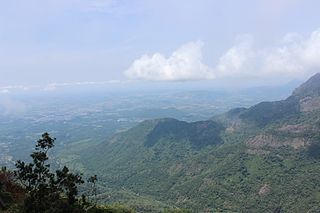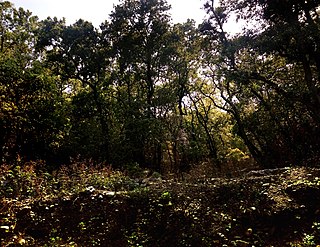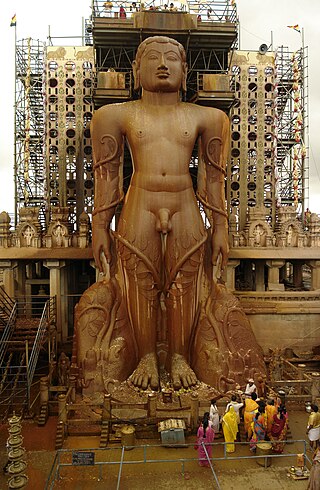
Kodagu district is an administrative district in the Karnataka state of India. Before 1956, it was an administratively separate Coorg State, at which point it was merged into an enlarged Mysore State.

Zealandia, formerly known as the Karori Wildlife Sanctuary, is a protected natural area in Wellington, New Zealand, the first urban completely fenced ecosanctuary, where the biodiversity of 225 ha of forest is being restored. The sanctuary was previously part of the water catchment area for Wellington, between Wrights Hill and the Brooklyn wind turbine on Polhill.

The Cardamom Hills or Yela Mala are mountain range of southern India and part of the southern Western Ghats located in Idukki district, Kerala, India. Their name comes from the cardamom spice grown in much of the hills' cool elevation, which also supports pepper and coffee. The Western Ghats and Periyar Sub-Cluster including the Cardamom Hills are UNESCO World Heritage Sites.

The Cardamom Mountains, or the Krâvanh Mountains, is a mountain range in the southwest part of Cambodia and Eastern Thailand. The majority of the range is within Cambodia.

The Nilgiri Biosphere Reserve is a biosphere reserve in the Nilgiri Mountains of the Western Ghats in South India. It is the largest protected forest area in India, spreading across Tamil Nadu, Karnataka and Kerala. It includes the protected areas Mudumalai National Park, Mukurthi National Park, Sathyamangalam Wildlife Sanctuary in Tamil Nadu; Nagarhole National Park, Bandipur National Park, both in Karnataka; Silent Valley National Park, Aralam Wildlife Sanctuary, Wayanad Wildlife Sanctuary, and Karimpuzha Wildlife Sanctuary in Kerala.

Kalesar National Park and adjacent Kalesar Wildlife Sanctuary (13,209 acres are protected areas in Kalesar of Yamunanagar district of Haryana state in India, 46 kilometres from Yamunanagar city, 122 kilometres from Chandigarh. Kalesar National Park was established in 2003. Kalesar National Park and Kalesar Wildlife Sanctuary are contiguous to Simbalbara National Park in Himachal Pradesh and Rajaji National Park in Uttarakhand. Kalesar is a popular destination for leopards, panthers, elephants, red jungle fowl and bird-watching. This forested area in the Shivalik foothills is covered primarily with sal with smattering of Semul, Amaltas and Bahera trees as well. Wildlife jeep safaris are available on 3 tracks. Park is closed July to September and during the remaining months visiting hours are 6 am to 10 am and 4 pm to 7 pm during summers, and 7 am to 11 am and 3.30 pm to 6 pm during winters.

Nagarahole National Park is a national park located in Kodagu district and Mysore district in Karnataka, India.

Bhadra Wildlife Sanctuary is a protected area and tiger reserve as part of the Project Tiger, situated in Chikkamagaluru district, 23 km (14 mi) south of Bhadravathi city, 38 km (24 mi) 20 km from Tarikere town, northwest of Chikkamagaluru and 283 km from Bengaluru city in Karnataka state, India. Bhadra sanctuary has a wide range of flora and fauna and is a popular place for day outings. The 1,875 m (6,152 ft) above MSL Hebbe Giri is the highest peak in the sanctuary.

Karnataka, the sixth largest state in India, has been ranked as the third most popular state in the country for tourism in 2014. It is home to 507 of the 3600 centrally protected monuments in India, second only to Uttar Pradesh. The State Directorate of Archaeology and Museums protects an additional 752 monuments and another 25,000 monuments are yet to receive protection.

The World Land Trust is a UK registered charity. It raises money to buy and then protect environmentally-threatened land in Africa, Asia, and Central and South America. In 2018 it claimed to have raised more than £25 million and to have bought more than 3000 km2 (1200 sq mi) of land in about twenty different countries.

The state of Karnataka in South India has a rich diversity of flora and fauna. It has a recorded forest area of 38,720 km2 which constitutes 55 of the geographical area of the state. These forests support 25% of the elephant population and 20% of the tiger population of India. Many regions of Karnataka are still unexplored and new species of flora and fauna are still found. The mountains of the Western Ghats in the western region of Karnataka are a biodiversity hotspot. Two sub-clusters of the Western Ghats, Talacauvery and Kudremukh, are on a tentative list of sites that could be designated as World Heritage Sites by UNESCO. The Bandipur and Nagarahole national parks which fall outside these subclusters were included in the Nilgiri biosphere reserve in 1986, a UNESCO designation. In the Biligiriranga Hills the Eastern Ghats meet the Western Ghats. The state bird and state animal of Karnataka are Indian roller and the Indian elephant. The state tree and state flower are sandalwood and lotus. Karnataka is home to 524 tigers.

The Mhadei Wildlife Sanctuary is a 208.5-km2 (80.5-mi2) protected area in the Indian state of Goa in the Western Ghats of South India. It is located in the North Goa District, Sattari taluka near the town of Valpoi. The sanctuary is an area of high biodiversity, and is being considered to become a Project Tiger tiger reserve because of the presence of Bengal tigers.

The Nari Shakti Puraskar is an annual award given by the Ministry of Women and Child Development of the Government of India to individual women or to institutions that work towards the cause of women empowerment. It is the highest civilian honour for women in India, and is presented by the president of India on International Women's Day at Rashtrapati Bhavan in New Delhi. The award was instituted in 1999 under the title of Stree Shakti Puraskar, renamed and reorganised in 2015. It is awarded in six institutional and two individual categories, which carry a cash prize of 200,000 and 100,000 rupees, respectively.

Pamela Gale Malhotra is an American animal sanctuary owner who lives in India. She was awarded India's highest award for women, the Nari Shakti Puraskar for her work at the SAI Sanctuary.

Sonia Jabbar is an Indian plantation owner and wildlife conservationist. Starting in 2012, she transformed her tea plantation in Darjeeling to accommodate and facilitate the safe passage of elephants during their migration between Nepal and Assam. The Wildlife Trust of India recognised the plantation as the Green Corridor Champion of North Bengal; the University of Montana, US, certified it Elephant Friendly. She then initiated additional projects for elephant conservation, including a re-wilding project to create a 100-acre forest, and a pilot crop insurance project for neighbouring farms. In 2019, she was awarded the Nari Shakti Puraskar, India's highest civilian award for women.

Deepika Kundaji is an Indian farmer whose methods gained national attention and an award from the Government of India. The Nari Shakti Puraskar award was made by the President of India, Ram Nath Kovind. The award is India's highest civilian award for women.
Sathanur is a village in Ramanagara district of Karnataka, India. It is located around 70 km from the city of Bengaluru. The Bengaluru - Coimbatore National Highway 948 passes via this town.

Sethuram Gopalrao Neginhal was an Indian forest official and conservationist who is credited with generating the green cover around the Indian city of Bangalore leading to the city being referred to as The Garden City. He was associated with the launch of Project Tiger and led wildlife conservation actions including development of the Bandipur Tiger Reserve. In addition to being an expert on wildlife and plant life he was an awarded wildlife photographer.
Aditya 'Dicky' Singh was an Indian wildlife conservationist and wildlife photographer.


















